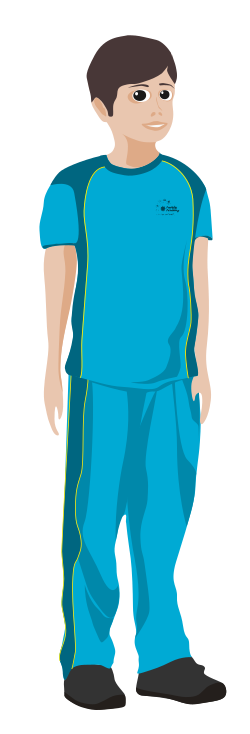Aurinko Academy – Premier Middle and High School in Bangalore
Admissions are open throughout the year for like-minded families to join our community.
The Middle and High School is a beautiful part of the journey at Aurinko. The day starts with administrative tasks. Children are in charge of the Assembly, maintaining discipline, guiding younger children or training new children. Children and Assembly starts at 8 am. Children stand barefoot on the earth facing the sun, and chant the Gayathri Mantra, The Great Invocation and sing the National Anthem. They also perform chakral exercises that cleanse and energise their energy bodies and in turn their physical bodies. Announcements about any visitors, or changes to schedules are made. A Sanskrit song is sung for anyone whose birthday falls on that day.
Middle and High School in Bangalore
(6th to 10th grade)
Children at this stage start applying and refining their academic, non-academic and life skills to enter into a mature teenage/adolescence world. This is a very crucial stage in a child’s life where the right balance between all facets of learning can impact a child positively. We provide the means for it by creating the right atmosphere and guidance.
Grades 6 and 7
Grade 6 and 7 are the crucial years when children draw upon the skills learnt in the Primary and apply them to explore new concepts. They also learn how to teach themselves and peers. The dependency on the Teacher is slowly reduced in these classes. They also learn to sit for extended hours of time, research and troubleshoot any hurdles in meeting their Learning objectives and expectations. The quantity and quality of their academic output is now far better than Primary. They also become self confident as this is their success and they did it themselves.
Children at this age also start taking responsibility of their actions, become observant and learn to stand up for their peers or help them by identifying a need. Initiative, Leadership and Collaboration are skills being perfected at this age.
Children at this grade become the eyes, ears and hands of the school administrative team. They are trained to be great volunteers in running the school in different areas of their natural inclination.
Continuous and Comprehensive Feedback by all Teachers and ongoing communication with parents, thereby gaining their co-operation, help in co-parenting the children, resulting in well rounded students.
An open approach at school allows them to practice their communication skills and express their thoughts, words and feelings fearlessly.
Different opportunities to use their bodies to learn and techniques taught in the workshop help them to gain important skills for life which slowly become a part of their Toolkit for Life.
We are aware we are training children for jobs that do not even exist as of today. Hence great emphasis is laid on skilling so they have a fulfilled life in the future.
Grade 8
Grade 8 is an important stage where the children spend the year understanding themselves, their aspirations and match it to their aptitude, achievements and attitudes. They, together with parents embark on an inquiry into the paths they would like to choose.
Their subjects for the next few years will depend on this journey. The Board through which the child would like to complete his Grade 10/12 will also be chosen at this time. The school will at all times provide guidance to the child and the parent during this whole year.
Grade 10
As the child progresses to the 10th Board, focus is shifted to a more rigorous approach that helps them to develop their higher order thinking skills, abstract thinking, life skills related to adolescence, values, exposure to different career options and exploration of their aptitude in different disciplines. It also steadily equips them with test taking skills and makes them exam-ready while still retaining the child within them.
Children also get exposed to several career awareness workshops, personality building workshops, mini internship programs, entrepreneurial mentoring etc. to help them align their goals to the real world.
The best of Aurinko environment
The Middle/High and Senior Secondary Classrooms continue to have extended variations of the Primary Classroom to facilitate 21rst Century Learning Outcomes.
These include the collaborative environment, opportunities for creative expression, inquiry-based approach, justification for answers, writing for reflection, use of a problem-solving methodology, hands-on learning, teacher as facilitator, transparent assessment etc.
Developmental Domains
Teachers ensure all our programs and interventions touch upon the following Developmental Domains at all times.

Identity Development and Movement Toward Independence
- In/External influences.
- Emotions and moods.
- Self expression and effective communication.
- Handling friendships.
- Handling stress.
- Reflecting on Self and Behaviour.
- Making decisions.

Ethics and Self-Direction
- Rules and Limits.
- Making Right Choices.
- Managing Distractions and Attractions – right perspective on harmful addictions.
- Ideals and selection of role models.
- Goal setting.
- Moral reasoning.
- Developing insight.
- Personal dignity and self-esteem.


Physical changes
- Awareness of personal space.
- Awareness of appropriateness of interactions with the other gender.

Future Interests and Cognitive Development
- Career Awareness.
- World of Work and Work Habits.
- Understanding the gaps in self and working on the same.
- Creative Explorations.
- Anxiety management.

Sexuality
- Understanding and accepting their own body and its needs.
- Sexual Identity.
- Understanding and managing gender differences.
The 21st century skill sets
The 21st century skill sets we ensure that children master before they step out into the real world are as follows. These comprise 35 core social, emotional and cognitive skills deemed critical for college, career and life success.

Personal Mindset
- Needs minimal supervision to complete tasks.
- Attempts to complete tasks independently before asking for help.
Follows rules/directions as required by the task/situation. - Maintains focus on tasks despite internal (e.g., emotional) and/or external distractions.
- Avoids actions that have produced undesirable consequences or results in the past.
- Strives to overcome barriers/set-backs, seeking assistance when needed.
- Adapts approach in response to new conditions or other

Collaboration
- Completes tasks as they have been assigned or agreed upon by the group.
- Helps team members complete tasks, as needed.
- Encourages the ideas, opinions, and contributions of others, leveraging individual strengths.
- Provides feedback in a manner that is sensitive to others’ situation/feelings.
- Clarifies areas of isagreement/conflict that need to be addressed to achieve a common goal.
- Seeks to obtain resolution of disagreements/conflicts to achieve a common goal

Social Awareness
- Recognizes the consequences of one’s actions.
- Balances own needs with the needs of others.
- Takes into consideration others’ situations/feelings.
- Develops and implements strategies for navigating in different contexts (i.e., manages different patterns of behavior, rules, and norms

Verbal Communication
- Organizes information that serves the purpose of the message, context, and audience.
- Uses and adjusts communication strategies as needed based on the purpose of the message, context, and audience.
- Signals listening according to the rules/norms of the context and audience.
- Seeks input to gauge others’ understanding of the message.
- Asks questions to deepen and/or clarify one’s understanding when listening to others

Problem solving
- Defines problems by considering all potential parts and related causes.
- Gathers and organizes relevant information about a problem from multiple sources.
- Generates potential solutions to a problem, seeking and leveraging diverse perspectives.
- Identifies alternative ideas/processes that are more effective than the ones previously used/suggested.
- Evaluates the advantages and disadvantages associated with each potential solution identified for a problem.
- Selects and implements best solution based on evaluation of advantages and disadvantages of each potential solution

Planning for Success
- Sets and prioritizes goals that reflect a self-awareness of one’s capabilities, interests, emotions, and/or needs.
- Breaks goals into actionable steps.
Accurately estimates level of effort and establishes realistic timelines. - Manages time to complete tasks on schedule.
- Applies existing/newly acquired knowledge, skills, and/or strategies that one determines to be useful for achieving goals.
- Monitors progress and own performance, adjusting approach as necessary.
- Demonstrates a belief that one’s own actions are associated with goal attainment
A typical day schedule

Classes Start
Children move to the classes after the Assembly.
8:30 am

Academics
English, Math, Science, Social Sciences and Languages are classified under Core Subjects.
High School has subjects like Economics, Business Studies, Psychology, Homescience as well.
8:30 – 9:00 am

Breakfast/Snack
Breakfast/Snack from Mistea, a healthy kitchen by an Aurinko Parent
9:00 – 9:15 am

Academics / Co-curriculars
Double academic periods for core subjects and one period of sports and one period of Computers
9:15 – 11:55 am

Lunch served from Mistea
Lunch and Snack are socialising time as well as happy times at Aurinko. children are encouraged to eat healthy. A prayer of gratitude is chanted before eating.
11:55 am

Academics, Theatre or workshop
One period for core subjects/theatre/workshop and some days languages
12:30 – 2:30 pm

Home Time
Children congregate, greet each other and listen to any announcement. Older children ensure all the younger ones get into buses and then leave in the Aurinko Buses
2:30 pm
Ready to Make a Change?
Our team will be happy to connect.

